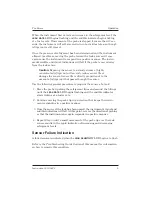
14
Tru Pointe
Instruction 0019-9328
Troubleshooting Guide
The following table lists the causes and remedies for the most common
problems that may occur with the instrument.
If the information in Table 1 does not solve the problem, or for help with
any prob lem that is not listed, please contact one of the Bacharach Sales/
Service Cen ters listed in Section
Parts & Service
.
TABLE 1. TROUBLESHOOTING GUIDE
Symptom
Probable Cause & Remedy
Instrument does not turn
ON.
a. Batteries are dead or installed back-
ward. Install two fresh ‘D’ alkaline bat-
teries per Section
Battery Installation
.
b. Faulty refrigerant sensor. Remove sen-
sor and turn ON instrument. If instru-
ment now operates, replace sensor per
Section
Sensor Replacement
.
The
POWER
ON
LED is
fl
ashing.
Low battery indication. Replace batteries
per Section
Battery Installation.
The
HIGH
SENSITIVITY
LED
is
fl
ashing in clean air.
a. Sensor depleted or faulty. Replace sensor
per Section
Sensor Replacement
.
b. Batteries are nearly depleted. Replace
per Section
Battery Installation
.
The
LEAK
RATE
LED is
turned on steady, and the
audible indicator is produc-
ing a steady tone.
a. This is normal during warm up. After
warm up the
fl
ash/tick rate should slow
down to less than 1 or 2 times per second.
b. Probe tip clogged, not allowing air to
fl
ow over sensor. Unclog probe tip.
Instrument does not re-
spond to the presence of
refrigerant.
a. Sensor nearly depleted or faulty. Replace
sensor per Section
Sensor Replacement
.
b. Probe assembly loose. Push nose cone of
probe assembly back into instrument.
c. Probe tip clogged, not allowing air to
fl
ow over sensor. Unclog probe tip.
d. Crack in rubber sheathing that covers
the probe’s
fl
exible tube, allowing air to
enter through the crack. Replace probe
assembly.
Troubleshooting



















